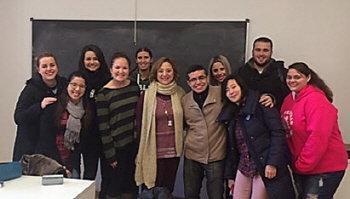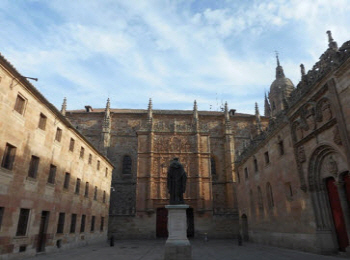By BAE Su Hyen, student at SNU College of Liberal Studies
In the most dormant time of the year, what is a better way to spend winter vacation other than snuggled up in the corner of your bed, thinking about your ex while listening to the Strokes? I figured that would be to travel to what seemed to me an over-exotified land of Gaudi and soccer. But I didn’t want to be the naive, Asian girl backpacker and end up the victim of pickpockets and a population of 23% unemployed youth. So I needed some kind of assurance that I would be safe, and more importantly, perhaps learn some kind of substantial knowledge from an intangible idea of a wild trip. I found the perfect match while walking around the humanities buildings – a poster announcing that the Department of Hispanic Language and Literature would provide a fully funded language course trip to the University of Salamanca in Spain.
I applied with doubts knowing that the chances of me receiving the opportunity would be very slim -- the more closely one is affiliated with the Department of Hispanic Language and Literature, the greater the chances of being accepted into the program. For example, out of the twelve people who went to Salamanca, ten were students from the Department of Hispanic Language and Literature. As for myself, I had participated in the Summer Spanish Camp, taken four classes offered by the department, and had the experience of learning Spanish for a long time, but had never set my feet in a Spanish-speaking country. If you are thinking of applying to a language camp, I would advise you to stay interested in the department’s activities (especially the summer language camps held at SNU) and take classes that prove your interest.
The official language program began on January 7, but I decided to travel to other countries in advance. After two weeks of backpacking in the nations of former colonial empires, I finally arrived in Salamanca on the evening of January 6.
The language experience at Salamanca rekindled my fading interest for Spanish. The program required us to attend five hours of class on the weekdays. Two hours of grammar class each morning grounded our understanding of the language in more fundamental and advanced ways. Compared to grammar lessons at SNU, the classes at Salamanca provided more in-class engagement and conversation leading to higher concentration and understanding of the usage of the grammar. One disadvantage though was that too much class engagement slowed down the speed of learning the lessons.

The language experience at Salamanca rekindled
my fading interest for Spanish. The program required us
to attend five hours of class on the weekdays.
Even more useful than the grammar classes were the elective classes. I chose conversation, literature, and art to learn for the rest of the afternoon. Other students selected Spanish history, business Spanish, writing, film, Spanish culture, Arabic history of Spain and so on. Although I had taken grammar classes in Spanish before, it was my first time to learn something in the same language. I realized the ways in which Spanish could be used as a language to transmit knowledge -- that is, as more than merely a subject to learn. The elective courses changed my perspective of the Spanish language. Learning literature and art, while improving my listening, vocabulary, and overall comprehension of Spanish made me realize how fun and practical learning Spanish can be. I had forgotten my original curiosity and love of the language dulled by years of learning Spanish by means of plain grammar lessons taught in Korean. Salamanca courses not only improved my Spanish skills, but helped me learn other subjects taught in Spanish. Spanish has now become a tool and means, rather than only something to learn in itself.
Salamanca itself is a studious and religious city containing the relics of medieval castles and churches.

Salamanca itself is a studious and religious city containing
the relics of medieval castles and churches
The Roman Bridge, originally constructed in the year 89, looms over the shimmering body of the Tormes River. Nearby the bridge is a statue of Lazarillo and the Blind Man from the story Lazarillo de Tormes, symbolic of the picturesque novel genre. The garden of Huerto de Calixto y Melibea, a notable place in La Celestina, another masterpiece of Spanish literature after Don Quixote, boasts a glowing sunset enough to comfort youthful melancholy. Such literary allusions and sculptures of writers and theologians imbue the city with intellectual spirits. In the city center, the Salamanca Cathedral, with its quixotic spaceman décor, chimes its bells the same way it has since the 16th century.
While its historic treasures give Salamanca many merits, Salamanca is best known as the home of Spain’s oldest university. The University of Salamanca gained a reputation as the scholarly center of Europe following its establishment in 1218. The tradition lives on to this day, giving the city its air of sacred spirit and liveliness, full of young students. Nowhere else in Spain can one find such a harmonious balance of the historic and new, intellectual freedom and tradition.
More information about the Spanish Language Camp can be found on the Department of Hispanic Language and Literature website. Complementing the Winter Spanish Camp in Salamanca, the department offers a “Summer Spanish Camp” for one week providing a similar experience of learning Spanish with native Spanish--speaking professors.
Other language departments also offer summer and winter language camps. Undergraduates of the College of Humanities or Departments of Political Science and International Relations, Geography, and Sociology can apply. This winter, the Department of Asian Languages and Civilizations funded a Japanese language program at Kyushu University. The Department of French Language and Literature also sends students to the University of Burgundy (Université de Bourgogne) every year.
Written by BAE Su Hyen, SNU English Editor, suhyenbae@snu.ac.kr
Reviewed by Eli Park Sorensen, SNU Professor of Liberal Studies, eps7257@snu.ac.kr
Proofread by Melora Brett Briana Johnson, SNU English Editor, morningcalm2@gmail.com

